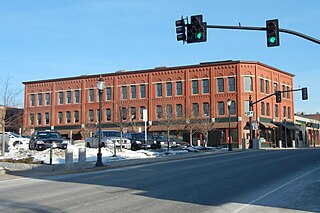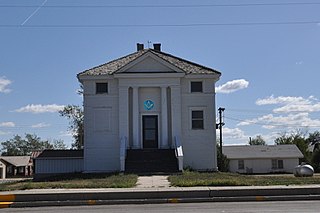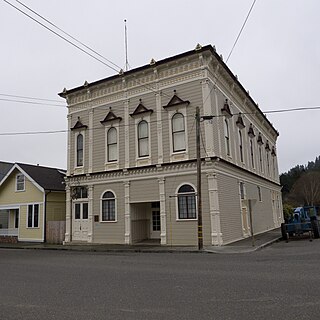
Orangeville is a village in Stephenson County, Illinois. The town's sign lists the population at 800 as of January 2021. The population in 2020 was 738. The population according to the 2010 census was 793, up from 751 in 2000. Using the 2020 population of 738 Orangeville is the 741st largest city in Illinois and the 11,650th largest city in the United States. Orangeville is currently declining at a rate of -0.94% annually and its population has decreased by -6.94% since the 2010 census. The area's earliest white settlers arrived in the year 1833, and the village was platted in 1851 by John Bower, who is considered the village founder. In 1867 Orangeville was incorporated as a village. The town's central business district contains several 19th century commercial buildings, many of which were built during the railroad boom of 1888–1914. By the time the Great Depression was ongoing, business in Orangeville had started to decline, with the last bank closing in 1932. In 1956 another bank started operating in the village and is still in town today. Some recent infrastructure jumps have restored some of the village's old decor.

The Ancient Free and Accepted Masons Lodge 687, also known as the Independent Order of Odd Fellows J.R. Scruggs Lodge 372, is a building constructed in 1876 as a Masonic Hall. It is located in downtown Orangeville, Illinois, a small village in Stephenson County. The building, originally built by the local Masonic Lodge, was bought by the locally more numerous Independent Order of Oddfellows fraternal organization in 1893. The building has served all of Orangeville's fraternal organizations for more than 125 years, from the time it was built. The two-story, front gabled building has Italianate architecture elements. It had a rear wing added to it in 1903. By 2003, the first floor has been returned to use as a community center, holding dinner theatre and other community functions, much as the building had originally served the community until first floor space was rented out for commercial use in the late 19th century. The building was listed on the U.S. National Register of Historic Places in 2003. The building is the home of the Mighty Richmond Players Dinner Theatre (MRPDT) dinner theatre which seats 54 persons and has scheduled four different productions for the 2010 season. A $150,000 renovation of the building was recently completed. The building was listed on the National Register of Historic Places as AF and AM Lodge 687, Orangeville in 2003.

The Masonic Hall of Hiram Masonic Lodge No. 7 is a historic Gothic revival building on South 2nd Avenue in Franklin, Tennessee. Constructed in 1823, it is the oldest public building in Franklin. It is nationally significant as the site of negotiations leading to the Treaty of Franklin, the first Indian removal treaty agreed after passage of the 1830 Indian Removal Act. It was declared a National Historic Landmark in 1973. It continues to serve the local Masonic lodge.

The Masonic Block is an historic commercial block in Reading, Massachusetts. This three story brick building is distinctive in the town for its Renaissance Revival styling. It was built in 1894 by the local Reading Masonic Temple Corporation, and housed the local Masonic lodge on the third floor. The building was listed on the National Register of Historic Places in 1984.

The Hobart Masonic Hall is a historic building located in the village of Hobart in Delaware County, New York, United States. It was originally constructed in 1889 as a meeting hall for St. Andrew's Lodge No. 289.

The Masonic Temple is a historic Masonic building in Philadelphia. Located at 1 North Broad Street, directly across from Philadelphia City Hall, it serves as the headquarters of the Grand Lodge of Pennsylvania, Free and Accepted Masons. The Temple features the Masonic Library and Museum of Pennsylvania, and receives thousands of visitors every year to view the ornate structure, which includes seven lodge rooms, where today a number of Philadelphia lodges and the Grand Lodge conduct their meetings.

The Masonic Temple is a historic Masonic temple located at Warrensburg, Johnson County, Missouri. It was built in 1893–1894, and is a rectangular three-story, Italianate style red brick building with extensive sandstone trim. The building measures approximately 48 feet by 92 feet.

Masons' Hall, located in the Shockoe Bottom neighborhood of Richmond, Virginia was built during 1785 to 1787 by Richmond Lodge No. 13. The building is still the active home of and owned by Richmond Randolph Lodge No.19 who have met in their third floor lodge room continuously since Masons’ Hall was completed in 1787. It was listed on the U.S. National Register of Historic Places in 1973.

The Crane Hill Masonic Lodge is a historical Masonic building in Crane Hill, Alabama. Built in 1904, it is listed on the National Register of Historic Places.

Eureka Masonic College, also known as The Little Red Schoolhouse in Richland, Holmes County, Mississippi, is widely known as the birthplace of the Order of the Eastern Star, created by Robert Morris.

Washington Hall is a historic building and a registered city landmark in Seattle, Washington, that is listed on the National Register of Historic Places. It was originally built as a community center by the Danish Brotherhood in America, a fraternal organization, with meeting halls and one-room apartments for new immigrants. In 1973, the building was sold to the Sons of Haiti who leased the space to various tenants. It was purchased in 2009 by Historic Seattle and was renovated and re-opened in 2010.

Colonial Hall and Masonic Lodge No. 30 consists of two historic buildings located at 1900 3rd Avenue, South in Anoka, Minnesota. Both were owned by Anoka Lodge No 30 AF & AM, which was chartered on October 25, 1859. Colonial Hall, also known as the Aldrich House for its association with the house's first owners and occupants, local medical and civil leaders Dr. Alanson and Dr. Flora Aldrich, is a two-story wooden building built in 1904 in a combination of Colonial Revival and Greek Revival styles by local renowned architect Fredrick Marsh. The Aldrich House was purchased by the Anoka Lodge in 1921, and in 1922, construction began on the present two-story redbrick Masonic temple, which is located behind but to the north of the Colonial Hall. Designed and built in the Georgian Revival style, it was completed and occupied in 1923.

The Mt. Moriah Masonic Temple is a historic building in Kadoka, South Dakota. It was constructed in 1917, as a meeting hall for Mt. Moriah Lodge No. 155. The building was listed on the National Register of Historic Places in 2004 as Mt. Moriah Masonic Lodge No. 155. It has also been known as the Kadoka Masonic Hall.

The Masonic Temple in Ferndale, California is located at 212 Francis Street, in an Eastlake-Stick style building built in 1891. The Masonic Hall is a contributing property in the Ferndale Main Street Historic District which was added on 10 January 1994 to the National Register of Historic Places. Ferndale Masonic Lodge F & A. M. #193 holds meetings in the building.

The Home for Aged Masons, formerly known as the Masonic Widows' and Orphans' Home and the Middle Tennessee Tuberculosis Hospital, is a historic building in Nashville, Tennessee, USA.

Oriental Lodge No. 500, also known as Prince Hall Masonic Temple, is a historic building located in Indianapolis, Indiana, United States. It was designed by Rubush & Hunter and others and completed in 1916. It is a four-story, rectangular, steel frame and reinforced concrete structure with brick exterior walls. It has terra cotta decorative elements that are interpretations of Islamic architecture of the Middle East, North Africa, and Spain.

Modale School and Masonic Hall is a historic building located in Modale, Iowa, United States. Built in 1880, the two-story frame vernacular form structure served as the community's school building. In general, 19th century school buildings resembled churches, and the Modale School was no different. The rectangular, front gabled building originally had a prominent bell tower that projected from the main facade. In 1911 the local Masonic lodge converted the building into a theater on the main floor and their lodge hall on the second floor. At that time they added a rear addition, Colonial Revival details on the main facade and on the porches, and Masonic symbols on the front gable end. The Modale lodge dissolved their membership in 2004 and merged with the lodge in Missouri Valley, Iowa as both had lost membership over the years. They donated the building to Town and Country Arts. It was listed on the National Register of Historic Places in 2014.

The Waterloo Masonic Temple is a historic building located in Waterloo, Iowa, United States. The first Masonic lodge in town, No. 105 A.F. & A.M, was established on the west side of the Cedar River in 1857. Lodge No. 296 was organized on the east side of the river in 1871, and the two consolidated into one lodge eight years later. They built their first Masonic Temple in 1899 at the intersection of Sycamore Street and East Park Avenue. The city was in the midst of a period economic growth that would see its population double each decade from 1890 to 1910. By 1918 the Masons felt the need for a new facility. Property at the intersection of East Park Avenue and Mulberry Street was acquired in 1920. Local architect John G. Ralston, a fellow Mason, was chosen to design the new building in what has been termed the "Phoenician Revival" style. The exterior walls were completed in 1925, but the interior wasn't completed until 1928. It is a four-story structure built over a raised basement. Its exterior walls are composed of dark red brick accented with light grey limestone. The main façade features a central entrance pavilion with three entrance ways that terminate in Moorish peaks near the roofline. Various Masonic symbols are found carved into the stone, and decorative brickwork flanks the central stone pavilion. The building was listed on the National Register of Historic Places in 2013.




















